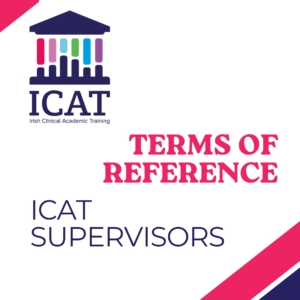Supervisor Database Search
Guidance for ICAT Supervisors
Supervisor Database
Full NameDr Eva Jimenez Mateos
Discipline of Physiology
Trinity College Dublin
Webpage:www.tcd.ie
Email hidden; Javascript is required.
- neuroscience and mental health
- Paediatrics
- Immunology
- Neonatology
- Neurology
The effect of perinatal asphyxia on the brain and development of babies is poorly understood. We know that babies suffering from hypoxia may develop neurological outcomes and current treatments are not effective in a subset of infants. More importantly, current treatments present a short time window to be effective and need to start within the first 6 hours after birth to increase their efficacy, e.g. therapeutic hypothermia. Our laboratory studies the role of inflammation in hypoxia and how affects brain development and explores ways to improve neurological outcomes. To achieve this, we use a combination of pre-clinical models, imagining and molecular biology techniques. The main project in the lab evaluates novel therapeutic targets, particularly anti-inflammatory, their therapeutical window by testing its efficacy later in life.
Key papers:
1. Leavy A, Phelan J, Jimenez-Mateos EM. Contribution of microglia to the epileptiform activity that results from neonatal hypoxia. Neuropharmacology. 2025.
2. Smith J, Menendez Mendez A, Alves M, Parras A, Conte G, Bhattacharya A, Ceusters M, Nicke A, Henshall D, Jimenez-Mateos EM*, Engel T. The P2X7 receptor contributes to seizures and inflammation-driven long-lasting brain hyperexcitability following neonatal hypoxia in mice. British Journal of Pharmacology. 2023 * corresponding author .
3. Leavy A, Jimenez-Mateos EM. Perinatal brain injury and inflammation: lessons from experimental murine models. Cells, 9 (12), 2640. 2020.
4. Quinlan S, Merino-Serrais P, Di Grande A, Dussmann H, Prehn JHM, Ní Chonghaile T, Henshall DC, Jimenez-Mateos EM. The Anti-inflammatory Compound Candesartan Cilexetil Improves Neurological Outcomes in a Mouse Model of Neonatal Hypoxia. Front Immunol. 2019 Jul 24;10:1752. doi: 10.3389/fimmu.2019.01752. eCollection (2019). (Senior)
5. Quinlan SMM, Rodriguez-Alvarez N, Molloy EJ, Madden SF, Boylan GB, Henshall DC, Jimenez-Mateos EM. “Complex spectrum of phenobarbital effects in a mouse model of neonatal hypoxia-induced seizures”. Sci Rep. Jul 3;8(1):9986. (2018) (Senior)
6. Rodriguez-Alvarez N, Jimenez-Mateos EM, Engel T, Quinlan S, Reschke CR, Conroy RM, Bhattacharya A, Boylan GB, Henshall DC Effects of P2X7 receptor antagonists on hypoxia-induced neonatal seizures in mice. Neuropharmacology. Apr;116:351-363 (2017)
7. Rodriguez-Alvarez N, Jimenez-Mateos EM, Dunleavy M, Waddington J, Boylan G, Henshall DC. Effects of hypoxia-induced neonatal seizures on acute hippocampal injury and later-life seizure susceptibility and anxiety-related behavior in mice. Neurobiology of Disease. Nov; 83:100. (2015)
Two percent of babies may develop complications during birth, including reduction in the level of oxygen to the brain, resulting in birth asphyxia or hypoxia, the leading cause of neonatal encephalopathy. The effect of hypoxia on the brain and development of babies is not well understood. The prognosis of infants suffering from neonatal brain damage is poor, accounting for 4 million neonatal death every year worldwide, 50% of infants will develop seizures in the neonatal period, and 70% of babies will suffer for adverse neuropsychological outcomes. Both diagnosis and treatment, however, remain a clinical challenge with current therapeutics, being effective only in a subgroup of patients and diagnostic/prognostic methods are either inaccurate or possible too late for an effective treatment. We know that babies suffering from hypoxia will develop neurological outcomes and these outcomes do not improve with current therapies. These failures may result from targeting specific neuronal proteins (e.g. Phenobarbital targets GABA-A receptor), without considering the other cells of the brain (e.g. microglia, astrocytes) or the specific nature and mechanism of the developing brain. Previous data by the laboratory suggests that neuroinflammation may be a key contributor to the pathophysiology of neonatal brain-damage and long-lasting neurological outcomes. This project will evaluate the contribution of neuroinflammation, particularly the interactions between microglia and astrocytes, to the neurological outcomes after hypoxia-seizures using a model of hypoxia in neonates. This project will use a novel comprehensive, and multidisciplinary approach to analyse inflammation as the main driver of neonatal brain damage by using our well-characterised mouse hypoxia model, imaging and behavior tests. This project will deeply understand the pathogenesis of neonatal brain damage and, ideally, discover novel drug targets with a higher response rate, minimal side effects, and improve neurological outcomes.

